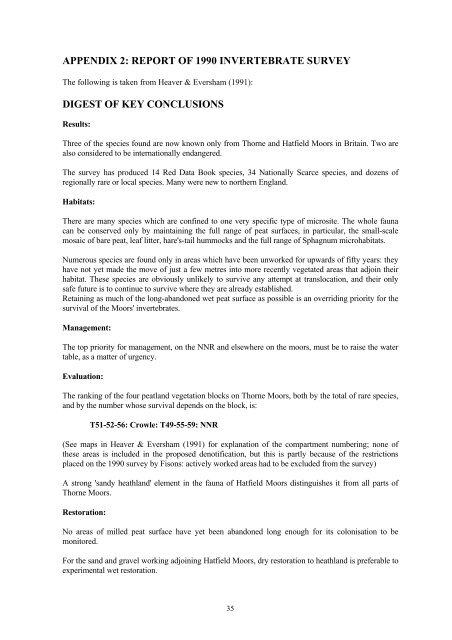free download - Thorne & Hatfield Conservation Forum
free download - Thorne & Hatfield Conservation Forum
free download - Thorne & Hatfield Conservation Forum
You also want an ePaper? Increase the reach of your titles
YUMPU automatically turns print PDFs into web optimized ePapers that Google loves.
APPENDIX 2: REPORT OF 1990 INVERTEBRATE SURVEY<br />
The following is taken from Heaver & Eversham (1991):<br />
DIGEST OF KEY CONCLUSIONS<br />
Results:<br />
Three of the species found are now known only from <strong>Thorne</strong> and <strong>Hatfield</strong> Moors in Britain. Two are<br />
also considered to be internationally endangered.<br />
The survey has produced 14 Red Data Book species, 34 Nationally Scarce species, and dozens of<br />
regionally rare or local species. Many were new to northern England.<br />
Habitats:<br />
There are many species which are confined to one very specific type of microsite. The whole fauna<br />
can be conserved only by maintaining the full range of peat surfaces, in particular, the small-scale<br />
mosaic of bare peat, leaf litter, hare's-tail hummocks and the full range of Sphagnum microhabitats.<br />
Numerous species are found only in areas which have been unworked for upwards of fifty years: they<br />
have not yet made the move of just a few metres into more recently vegetated areas that adjoin their<br />
habitat. These species are obviously unlikely to survive any attempt at translocation, and their only<br />
safe future is to continue to survive where they are already established.<br />
Retaining as much of the long-abandoned wet peat surface as possible is an overriding priority for the<br />
survival of the Moors' invertebrates.<br />
Management:<br />
The top priority for management, on the NNR and elsewhere on the moors, must be to raise the water<br />
table, as a matter of urgency.<br />
Evaluation:<br />
The ranking of the four peatland vegetation blocks on <strong>Thorne</strong> Moors, both by the total of rare species,<br />
and by the number whose survival depends on the block, is:<br />
T51-52-56: Crowle: T49-55-59: NNR<br />
(See maps in Heaver & Eversham (1991) for explanation of the compartment numbering; none of<br />
these areas is included in the proposed denotification, but this is partly because of the restrictions<br />
placed on the 1990 survey by Fisons: actively worked areas had to be excluded from the survey)<br />
A strong 'sandy heathland' element in the fauna of <strong>Hatfield</strong> Moors distinguishes it from all parts of<br />
<strong>Thorne</strong> Moors.<br />
Restoration:<br />
No areas of milled peat surface have yet been abandoned long enough for its colonisation to be<br />
monitored.<br />
For the sand and gravel working adjoining <strong>Hatfield</strong> Moors, dry restoration to heathland is preferable to<br />
experimental wet restoration.<br />
35


